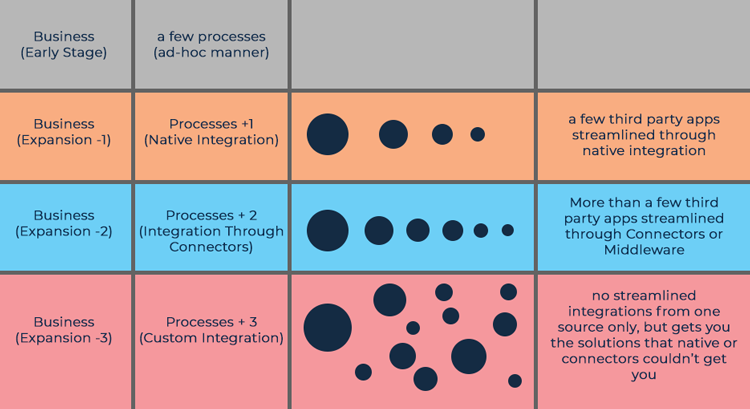Celigo is an integration platform that helps you connect your core platform with several other applications. Having that in your HubSpot account means you don’t need any other third-party connector to integrate apps to HubSpot regardless of the flow of the information.
To connect your HubSpot to anything, you just have to connect it to Celigo first. Then the door for integration with other apps opens up.
There are in-built integration templates or you can say workflows available that let you sync the data across platforms. However, you can always build your custom integration data flow to meet your business needs.
Why your business needs integration?
How does your company automate its business processes today, may not automate them the same way when it grows or expands. And, that’s when the need for more integration (preferably from one source) rises.
Any company in its early stages doesn’t have many processes. So, they are managed in an ad-hoc way i.e. solutions provided for specific requirements only and implemented only when they are needed. It’s an unplanned approach that supports only specific requirements at a particular time. However, whenever any business expands, its processes are increased, become more complex, and lose the ad-hoc grip. They demand a more planned, organized, and streamlined solution, without which the business starts suffering delays and errors in its processes.
Integrations are your way out of unplanned business strategies. When integrations are the new discussion topics in your business meetings, native and direct integrations do pop up in the conversations. Some of which are useful while the others do nothing to support your business growth. In that case, custom integrations either from scratch or through connectors come up as a viable option.

Native or Direct Integration: Integration solutions that your core platform offers by default with the third-party apps, just like you find certain apps in the HubSpot marketplace to integrate with.
Workflow Integrations: 360 NRS, SMS for HubSpot, Ring.io Power Dialer
Marketing Campaign Apps: Jotform, Gravity Forms, Lucky Orange
Payments Apps: Paycove, DepositFix, Qwilr
There are several other categories and several apps in those categories that you can connect your HubSpot to by default. These integrations follow a single workflow method and not much customization you can do there.
Integration through Connectors: There are certain middleware apps or connectors that let you connect with several other apps with multiple workflow options. These workflow options are more than what you get in Native Integration.
Here’s our detailed blog on connectors for integrations what they are and what they do.
The one that is not mentioned in that blog is Celigo. Computan recently did a project where a client wanted to connect its HubSpot account with a third-party app through Celigo. So we first had to integrate Celigo with HubSpot and then integrate the other app.
Celigo is an iPaas – Integration Platform as a Service, a platform that is built for both IT and business users that automates your business process across applications.
iPaas is a central platform that standardizes how data flow between apps to streamline the business processes. You can use an iPaas to share data between multiple applications.
For example, orders and inventory in online stores and accounting systems. The iPaas can even trigger actions based on that data like automatically sending an invoice when a sale is approved.
iPaas platforms also take care of critical integration requirements such as guaranteed data delivery and data governance so you don’t have to build these capabilities yourself.
How many cloud applications does your business use every day?
Make a list and see how many applications your business processes use and how many are under one roof and how many are handled individually. These tools solve every kind of business problem but those being scattered create another problem for the team. Managing different ends of solutions becomes cumbersome after a while. And because you use so many applications, your business processes are fragmented across many applications.
Every company needs an integrations strategy to address the growing complexity of more cloud applications through automation. Integrating your core business application with multiple third-party applications via a single connector such as Celigo helps you bring everything under one roof.
With Celigo’s guided visual interface, building powerful integrations becomes easy. Celigo offers advanced orchestrations, transformations, and customizations. You can leverage the hundreds of pre-built connectors, templates, and even integration apps to automate key business processes across popular applications. These integrations are fully configurable for your company’s needs.
Because the platform is designed for business and technical users, you can even choose to hand off certain integrations to be managed by less technical users leaving your team to focus on more strategic initiatives that drive the business ahead.
The agile companies set for growth need integration to scale. Celigo brings all the necessary integrations to one place.
Computan also got a request for Celigo HubSpot Integration. But it didn’t go as it was supposed to go.
The Goal of the Project: The goal was to perform two-way sync using a third-party tool called Celigo between Netsuite and HubSpot. They wanted to be able to sync companies, contacts, and sales orders between both systems.
What Did We Do: We tried to utilize Celigo tools to make the sync work such as creating flows one entity at a time and running them.
End Result: It didn’t go as expected. We did such integrations before in 2-3 weeks, but this project took more than 3-4 months and we didn’t reach anywhere as there were too many exceptional cases that we couldn't handle with third-party tools available in Celigo.
This reminds us that there is still room for improvement. There are still some business requirements that the connectors and native integration methods miss, for which only custom integration from scratch is available. Celigo might have to explore more business processes in order to meet exceptional scenarios.



